
परिभाषेन्दुशेखर: Paribhasendu Sekhara (Set of 2 Volumes)
Book Specification
| Item Code: | NZH056 |
| Author: | नागोजी भट्ट (Nagoji Bhatta) |
| Publisher: | Bhandarkar Oriental Research Institute, Pune |
| Language: | Sanskrit and English |
| Edition: | 2001 |
| Pages: | 813 |
| Cover: | Hardcover |
| Other Details | 8.5 inch X 5.5 inch |
| Weight | 940 gm |
Book Description
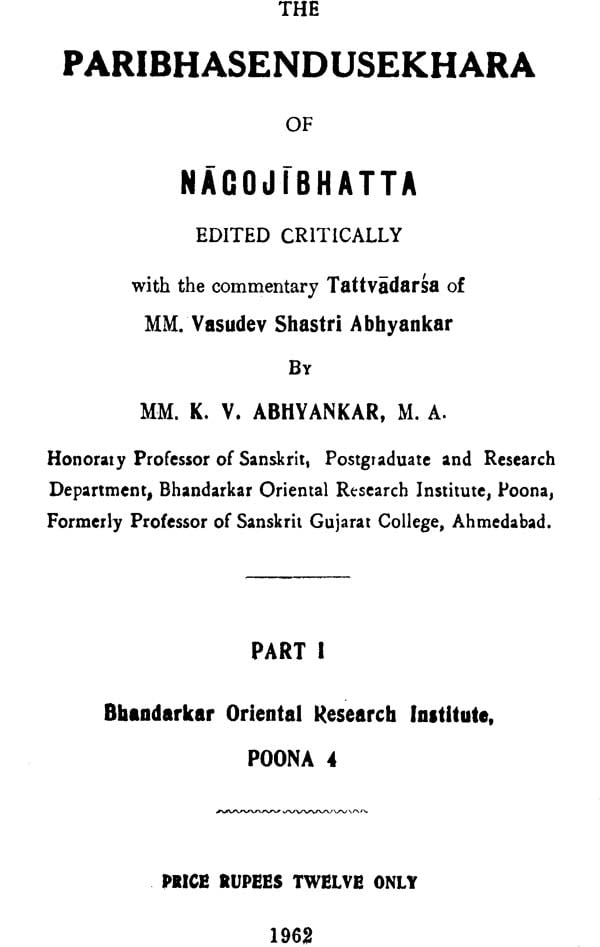
The text of this edition of Nagojibhatta’s Paribhasendusekhara is based upon the manuscript copy prepared of his own study of the work by Bhaskar Shastri Abhyankar in 1807 under the guidance of Nilakanth Shastri Thatte, the well-known Sanskrit scholar of the Peshwa Darbar at Poona. This manuscript is called A.
When Dr. Kielhorn prepared the press copy of this work which he edited in 1868, he used two manuscript copies called B and C. The Ms. B which he secured from Dr. Buhler was not very old, nor very accurate. The other Ms. called C, was better which was secured by him from Chintaman Shastri Thatte of Poona. Besides these two manuscripts on which Dr. Kielhorn based his text, he secured a manuscript of the commentary Kasika (Gada) of Vaidyanatha Payagunde which he used in correcting the text and preparing his footnotes. Dr. Kielhorn was able to secure manuscript copies of the commentaries Citprabha and Tripathaga on the Paribhascndusekhara. The differences in reading noted by Dr. Kielhorn, are given in the present edition marked by the same letters B and C.
At the time of the present edition which is prepared well-nigh a hundred years later, numerous manuscripts of the text became available out of which a few typical select manuscripts were used and the differences in readings were noted. The text given in the basic manuscript called A, was well-written and correct; at a few places it was improved with the help of the printed copy used for his study by the commentator, MM. Vasudev Shastri Abhyankar. The manuscript called D, bears 1813 A. D. as the date of its writing. Another manuscript called E appears to be older than A and D, but bears no date. The manuscript K and G, although written later, represent the text preserved and studied in the Vaisnava families of Maharashtra Grammarians. The manuscript called H, preserves the text used by grammarians in Gujarat.
The commentary ‘Tattvadarsa’ edited along with the text in this edition was written in 1886 by Mahamahopadhyaya Vasudev Shastri Abhyankar, a stalwart grammarian of Maharashtra in the first half of the present century. The manuscript copy of it, written by the author himself, was not available, but a copy of it, became available with great difficulty. Although there were numerous mistakes committed by the copyist in this copy, the text could be presented quite well and correct by the editor, as he, with the help of Pandit Shankar Shastri Marulkar, was able to correct the mistakes of the copyist. Pandit Shankar Shastri Marulkar and the editor were pupils of the commentator, and as they had the good fortune of studying the text under the commentator himself, they naturally knew many of the problems discussed in the commentary.
As stated in the introduction, at the time of the present edition, a large number of commentaries on the present work viz. the Paribhasendusekhara could be secured; so also, many independent works on Vyakarana Paribhasa were available. However, as the commentary ‘Tattvadarsa’ is a scholarly and critical one, and as the translation and notes, given by Dr. Kielhorn in his edition of the work, reprinted along with this edition as part II, are quite excellent and sufficient for a good study of the work, no attempt is made to add any notes by way of further explanation. A critical appreciation of the various commentaries on the Paribhasendusekhara and independent Paribhasa works is given in the introduction.
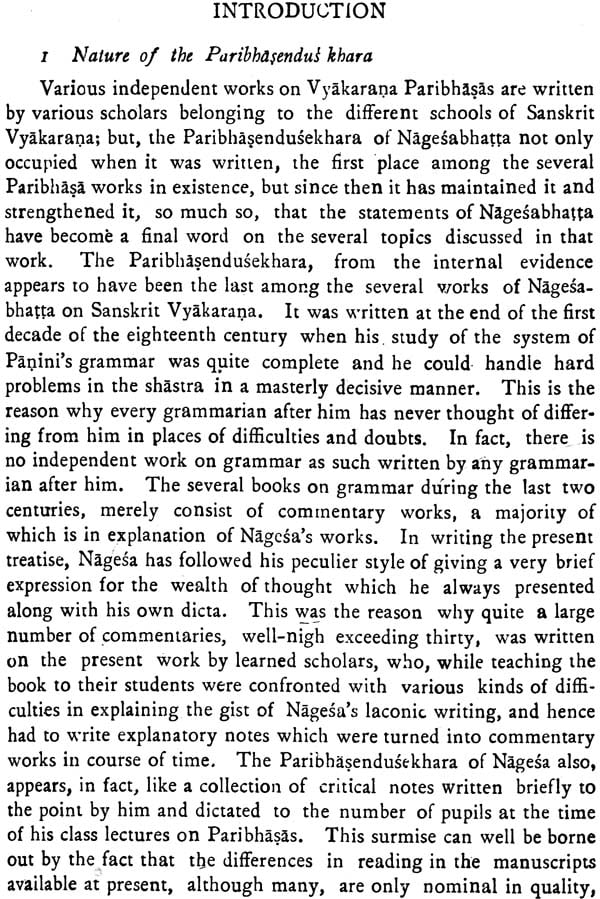
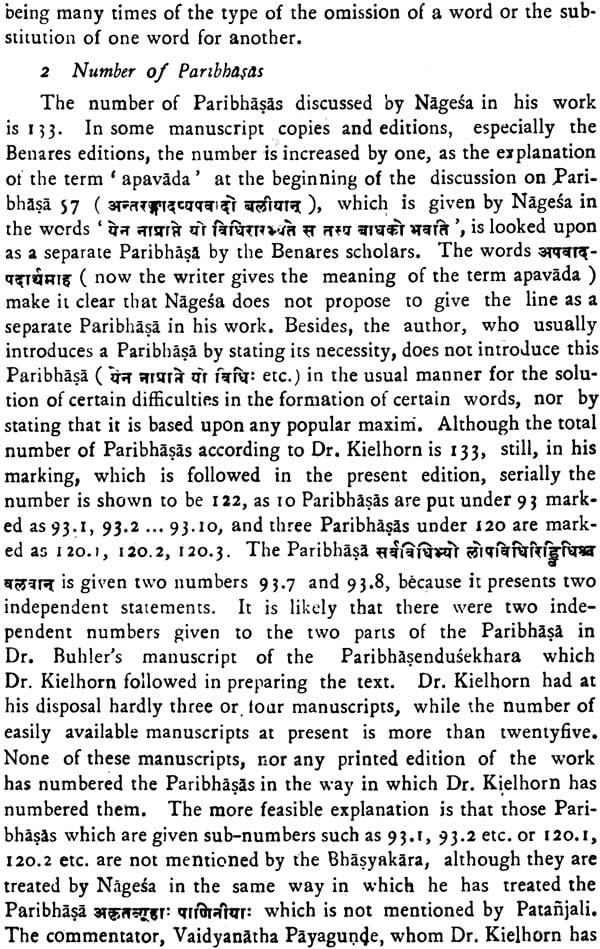
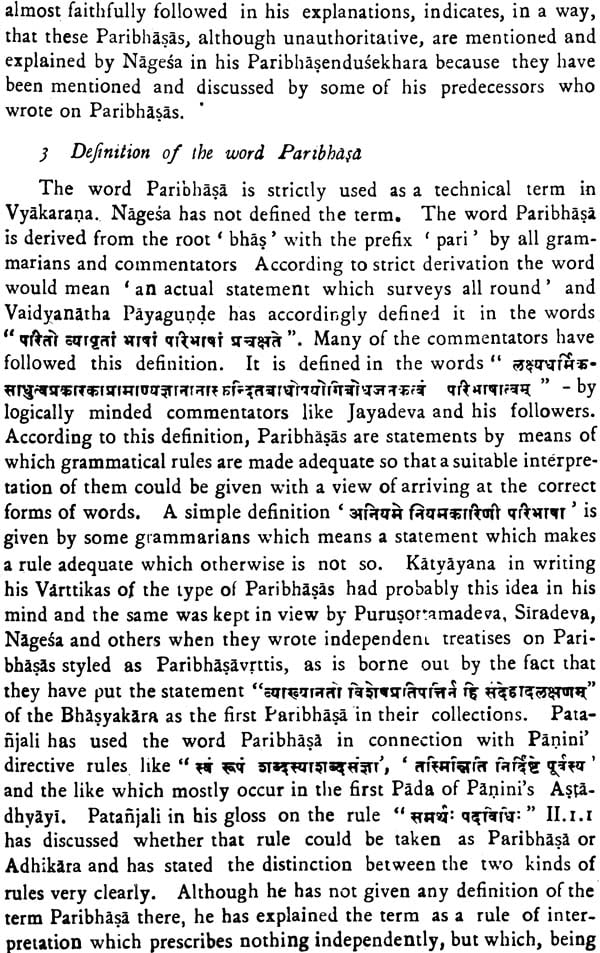


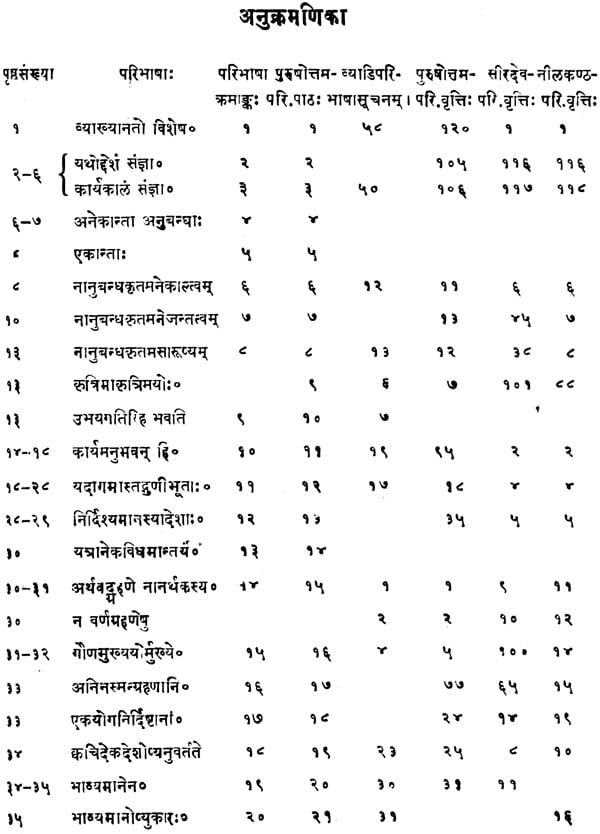
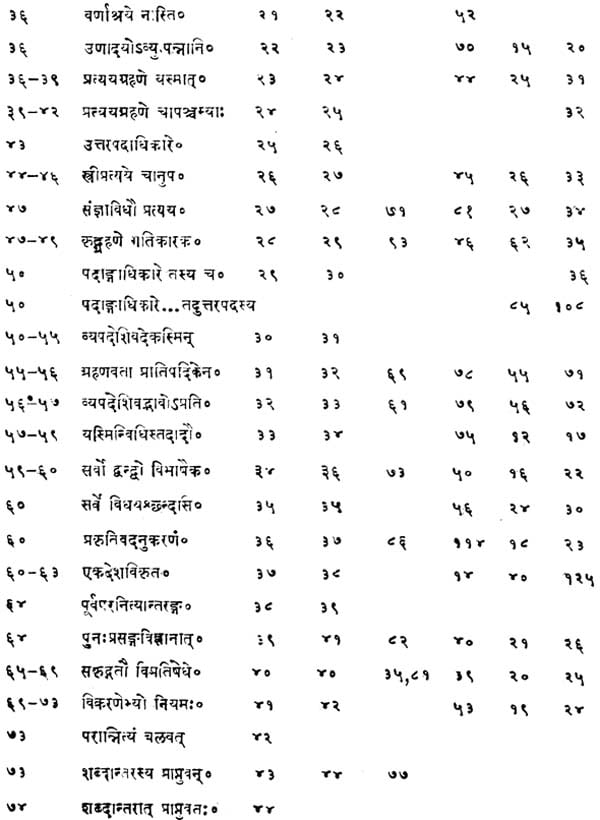


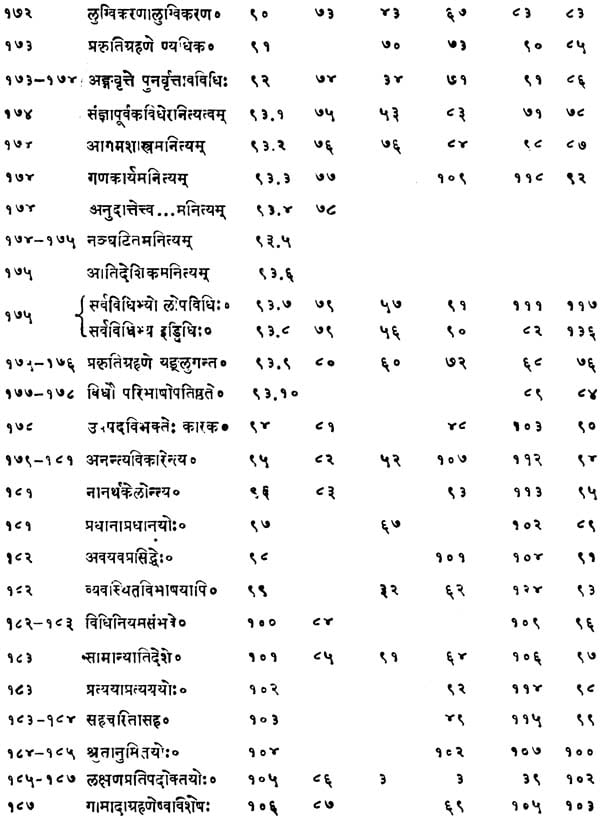
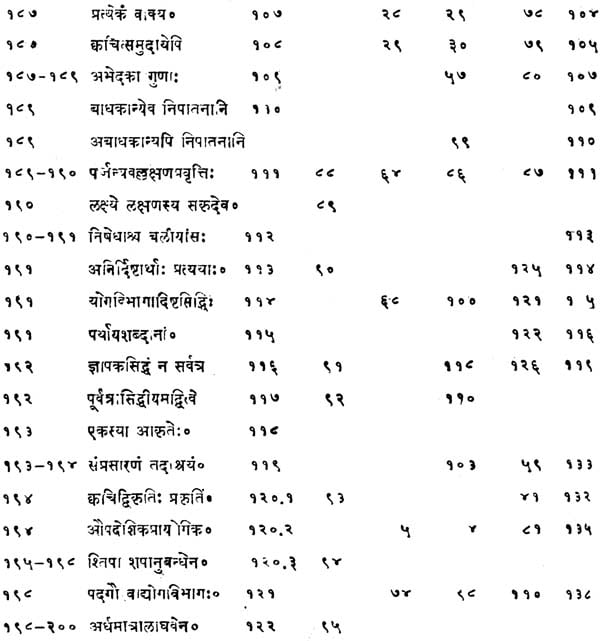
I. It is a universally acknowledged fact that, among the several works written by Nagesabhatta in the Sanskrit Sastras, the Paribhasendusekhara occupies a unique position. This is testified by the deep study of it which every student who seeks to gain proficiency in Sanskrit Grammar is required to make, as also by the number of commentaries written on it by learned scholars all over the country. More than eighty years ago, F. Kielhorn brought out the first critical edition of this work basing it upon three manuscript copies available to him, and adding to it an excellent translation into English with explanatory notes. He did the work with the valuable assistance of learned Pandits, which he has gratefully acknowledged in his preface. With the inherent modesty possessed by a learned scholar, he has made a remark in his preface that his translation with all its shortcomings and defects might not be quite unacceptable to the student of Sanskrit Grammar. Experience of the last seventy-five years has, however, shown that the translation of such a difficult work, so ably rendered by the learned Doctor, has met with praise at the hands of every English-knowing student of Sanskrit Grammar.
2. Since Kielhorn brought out the first edition of the Paribhasendusekhara and a critical edition of the Mahabhasya of Patanjali in three volumes, more than seventy-five years have passed, during which period many important works on Sanskrit Grammar in manuscript form have become available to critical scholars working in the field. These works were already there in the various collections, but on account of the peculiar method of study, followed by the old Indian scholars, they were left unread and unnoticed. The Sanskrit scholars following the traditional method of study were keen on making an intensive study of the subject, and the number of books read in each Sastra by a scholar did not exceed a dozen at the most. For instance, a sound scholar of Sanskrit Vyakarna had the text of the Astadhyayi committed to memory probably before he was ten or twelve years old, when he was, of course, not in a position to understand it, and thereafter he read the siddhantakaumudi, portions of the Praudhamanorama, with the Sabdaratna, the Laghusabdendusekhara, the Paribhasendusekhara, the Laghumanjusa or even the Paramalaghumanjusa and important portions of the Mahabhasya, of course taking care to see that he committed to memory the important portions of each of these Sanskrit texts. In some places in the northern and eastern parts of India, the kasika and its commentary the Nyasa were substituted for the Siddhantakaumudi and its commentaries, and the Paribhasavrtti of Siradeva for the Paribhasendusekhara of Nagesabhatta. The books, stated above, were read very thoroughly, and they were so completely mastered that no help of any index or reference book was needed by any sound scholar of the subject when he explained these texts to his pupils without even a manuscript copy of the texts in his hands.
3. In his preface Kielhorn has remarked: “It is sad to see the number of great Shastris, distinguished no less for their humility and modesty than for their learning and intelligence, diminish year after year and to feel that with them there is dying away more and more of that traditional learning which we can so ill dispense with in the interpretation of the enigmatic works of Hindu antiquity”. Unfortunately, the situation has worsened still more in recent years. It can be said that there were from time to time stalwart Vaiyakaranas in different parts of India, many of whom established distinct traditions of Vyakarana studies by devoting almost their whole time in doing teaching work. Varanasi and Poona were two great centres during the last two centuries or more, where, after Nagesabhatta, the names of the following Vyakarana Pandits, among others are still remembered with a sincere sense of pride and respect by generations of pupils created by them. They are Vaidyanatha Payagunde, Balashastri Ranade, Pandit Shivakumara, Jayadevamisra and Gangadharashastri Manavalli of Varanasi, and Nilakanthashastri Thatte, Raghavedracharaya Gajendragadkar, Bhaskarashastri Abhyankar, Ramashastri Godbole and Vasudev Shastri Abhyankar of Poona.
4. Kielhorn also remarks: “It appears to me all the more to be the duty of both Native and European Sanskrit scholars to save as much as can still be saved, and to fix in writing what in less than half a century will otherwise be irreparably lost”. Kielhorn himself took the lead in this respect, and his editions of the Paribhasendusekhara and the Mahabhasya have come to occupy an enviable position among the different editions of these works which have been made available from time to time. Since then, texts of treatises of first-rate value such as the Mahabhasyapradipa, the Pradipodyota or Vivarana, the Vakyapadiya, the Vaiyakaranabhasansara, the Laghumanjusa, the Paramalaghumanjusa, the Laghusabdendusekhara, the Prakriyakaumudi, the Siddhantakaumudi, the Kasika, the Padamanjari, the Nyasa and some others have been edited and published. It is, however, a matter of regret that many of these are not at all critically edited. Similarly, many texts are still in their manuscript form and need to be edited at as early a date as possible. Some of these are: the Mahabhasyadipika of Bhartrhari, Padavakyaratnakara of Gokulanath Mishra, the Brhacchabdaraina of Haridiksita and the Tantrapradipa of Maitreya Raksita.
5. In his preface, kielhorn has given a critical analysis and classification of the Paribhasa in three different ways, his criteria in this connection being (1) their position in the Bhasya, (2) their acceptance by Nagesa, and (3) their validity. He has not discussed their origin, the order of their mention, and their classification according to the subject-matter. He has plainly stated that to test independently the bearing and validity and to ascertain the authorship of every single Paribhasa would have necessitated an amount of labour which would have deferred the publication of the translation already delayed. All these questions have been discussed at some length by the present editor in his introduction to the text of the paribhasendusekhara and the Paribhasasamgraha which are being edited separately.
6. Sometime after Panini wrote his Astadhyaya, some Vrttis were written to explain and illustrate the Sutras. However, with a view to helping the correct interpretation of the Sutras it became necessary to lay down some radical principles, to give certain maxims and to state certain rules of guidance, derived directly or indirectly from the Sutras themselves, all of which are included in the term Paribhasa.






